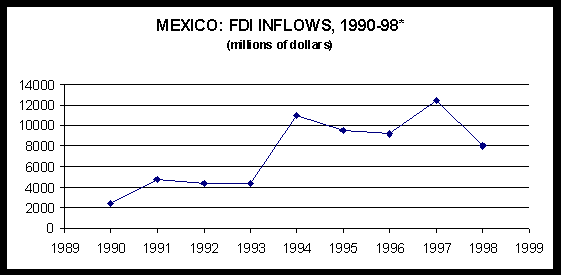| 1998 report on foreign investment in Latin America and the Caribbean MEXICO IS REGION’S SECOND LARGEST RECIPIENT OF
FOREIGN DIRECT INVESTMENT
- NAFTA connection is strong, says ECLAC report
-
Between 1985 and 1995, Mexico was the region’s principal recipient of
foreign direct investment (FDI), but in 1996 Brazil took the lead and kept it in absolute
terms the following year, reports the 1998 edition of ECLAC’s annual study, Foreign
Investment in Latin America and the Caribbean. However, FDI in Mexico was very
important in sustaining structural adjustments in the country’s economy. The
approximately US$8,000 million received during 1994-97 played a central role in this
transformation and, in particular, in Mexico’s integration into the continental
economy as part of the North American Free Trade Agreement (NAFTA).

*/ the 1998 figure is estimated by ECLAC
The main focal points for FDI in Mexico are manufacturing - both
assembly-based operations for export (such as apparel and electronic equipment) and
production for the domestic market (such as food, beverages and tobacco products) - and,
more recently, services. About 60% of total flows come from a single country, the United
States. While the creation of new assets was the principal form taken by FDI in the 1990s,
especially in the automobile industry, more recently mergers and acquisitions of private
assets have come to the fore, particularly in the food, beverage and tobacco industries
and in services such as retailing and banks. In most cases, the main focuses of FDI are
related to NAFTA, through the establishment of continent-wide systems of integrated
production or strategic positioning in the domestic market.
The principal corporate strategies of foreign investors in Mexico can be
summarized as follows:
The creation of continent-wide systems of integrated production, to
improve efficiency and competitiveness in the export of manufactures to the US. This
strategy tends to take the form of the creation of new assets in the apparel (Burlington,
Dupont), electronics (Compaq, Daewoo, Sony) and automotive (Chrysler, Ford, GM, VW,
Nissan) industries. Key ingredients of the strategy are relatively low wages and
preferential access to the US market under HTS 9802 or NAFTA arrangements. This strategy
is used particularly by US companies under pressure from Asian competitors in the US
market itself.
A new or expanded presence in the Mexican market for manufactures.
This strategy is common among US companies in food (PepsiCo), beverages (Anheuser Busch,
Labatt. PepsiCo, Coca Cola) and tobacco (Philip Morris, BAT), and is often based on the
acquisition of private assets. In these cases, FDI often responds to the strategic
dynamics in oligopolistic markets.
A new or expanded presence in the Mexican market for services. This
is increasingly common for the new globalizing services, such as telecommunications (Bell
Atlantic, Bell Canada, Lorel, Hughes) and finance (HSBC, BBV, Santander). It is also
evident in the retail trade (Wal-Mart). Some FDI is used to open up previously restricted
sectors. Again, the strategic behavior of firms in the internal market often determines
FDI initiatives.
In 1998, Mexico is likely to receive a total level of FDI similar to
previous years, as by mid-year over US$5,000 million had already been registered by
national authorities. The principal areas for which major investments have been announced
for coming years include automobiles (US$8,600 million), energy (US$2,800 million),
electronics (US$2,4000 million), transport (US$1,500 million), chemicals (US$1,300
million), telecommunications (US$1,200 million), food, beverages and tobacco products
(US$1,000 million), and textiles and apparel (US$900 million).
Back to summaries |